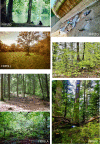Small terrestrial mammals (Rodentia and Soricomorpha) along a gradient of forest anthropisation (reserves, managed forests, urban parks) in France
- PMID: 36761546
- PMCID: PMC9836417
- DOI: 10.3897/BDJ.10.e95214
Small terrestrial mammals (Rodentia and Soricomorpha) along a gradient of forest anthropisation (reserves, managed forests, urban parks) in France
Abstract
Background: Understanding the relationships between wildlife biodiversity and zoonotic infectious diseases in a changing climate is a challenging issue that scientists must address to support further policy actions. We aim at tackling this challenge by focusing on small mammal-borne diseases in temperate forests and large urban green spaces. Small mammals are important reservoirs of zoonotic agents, with a high transmission potential for humans and domestic animals. Forests and large urban green spaces are ecosystems where efforts are undertaken to preserve biodiversity. They are put forward for their contribution to human well-being in addition to other ecosystem services (e.g. provisioning and regulating services). Moreover, forests and large urban green spaces are environments where small mammals are abundant and human/domestic-wildlife interactions are plausible to occur. These environments are, therefore, focal points for conservation management and public health issues.
New information: The European Biodiversa BioRodDis project (https://www6.inrae.fr/biodiversa-bioroddis) aims at better understanding the relationships between small terrestrial mammal biodiversity and health in the context of global change and, in particular, of forest anthropisation and urbanisation. Here, we present the data gathered in France. The dataset will enable us to describe the diversity of small terrestrial mammal communities in forested areas corresponding to different levels of anthropisation and to evaluate the variability of this diversity over time, between seasons and years.The dataset contains occurrences of small terrestrial mammals (Rodentia and Soricomorpha) trapped in forested areas in eastern France (administrative Departments: Rhône, Ain, Jura). The sampling sites correspond to different degrees of anthropisation. Forests included in biological reserves are the least anthropised sites. Then, public forests and urban parks experience increasing levels of anthropisation. Data were collected during spring and autumn 2020 (three to four sampling sites), 2021 (six sampling sites) and 2022 (four sampling sites). These variations in the number of sites between years were due to lockdown restrictions in 2020 or to the legal authorisation to trap around biological reserves granted in 2021 only. The capture of animals was carried out in various types of forests (pine, deciduous, mixed) and in different habitats within urban parks (wooded areas, buildings, hay storage yards, riverside vegetation, restaurants, playground for kids, botanical garden, landfills). Animals were captured using live traps that were set on the ground for one to 11 nights. During this study period, 1593 small mammals were trapped and identified. They belong to 15 species, amongst which were nine species of rodents (Muridae, Cricetidae, Gliridae) and six species of shrews (Soricidae). They were weighted (gram) and measured (cm): head-body length, tail length and hind-foot length. Sexual characteristics were also recorded.
Keywords: biodiversity; community; dilution effect; forests; global changes; rodents; shrews; urban parks.
Julien Pradel, Marie Bouilloud, Anne Loiseau, Sylvain Piry, Maxime Galan, Emmanuelle Artige, Guillaume Castel, Julien Ferrero, Romain Gallet, Geoffrey Thuel, Nathalie Vieira, Nathalie Charbonnel.
Figures





Similar articles
-
Prevalence, genetic diversity and eco-epidemiology of pathogenic Leptospira species in small mammal communities in urban parks Lyon city, France.PLoS One. 2024 Apr 10;19(4):e0300523. doi: 10.1371/journal.pone.0300523. eCollection 2024. PLoS One. 2024. PMID: 38598501 Free PMC article.
-
Atlantic small-mammal: a dataset of communities of rodents and marsupials of the Atlantic forests of South America.Ecology. 2017 Aug;98(8):2226. doi: 10.1002/ecy.1893. Epub 2017 Jun 28. Ecology. 2017. PMID: 28500789
-
ATLANTIC-CAMTRAPS: a dataset of medium and large terrestrial mammal communities in the Atlantic Forest of South America.Ecology. 2017 Nov;98(11):2979. doi: 10.1002/ecy.1998. Ecology. 2017. PMID: 28857166
-
Variation in species-specific responses to habitat fragmentation and land cover structure in urban small mammal communities.J Mammal. 2024 Oct 24;106(2):339-351. doi: 10.1093/jmammal/gyae121. eCollection 2025 Apr. J Mammal. 2024. PMID: 40144360 Free PMC article.
-
Assessing the conservation value of cemeteries to urban biota worldwide.Conserv Biol. 2024 Dec;38(6):e14322. doi: 10.1111/cobi.14322. Epub 2024 Jul 19. Conserv Biol. 2024. PMID: 39031118 Free PMC article.
Cited by
-
Exploring the potential effects of forest urbanization on the interplay between small mammal communities and their gut microbiota.Anim Microbiome. 2024 Mar 25;6(1):16. doi: 10.1186/s42523-024-00301-y. Anim Microbiome. 2024. PMID: 38528597 Free PMC article.
-
Prevalence, genetic diversity and eco-epidemiology of pathogenic Leptospira species in small mammal communities in urban parks Lyon city, France.PLoS One. 2024 Apr 10;19(4):e0300523. doi: 10.1371/journal.pone.0300523. eCollection 2024. PLoS One. 2024. PMID: 38598501 Free PMC article.
-
Shrews Under-Represented in Fruit Farms and Homesteads.Animals (Basel). 2023 Mar 11;13(6):1028. doi: 10.3390/ani13061028. Animals (Basel). 2023. PMID: 36978569 Free PMC article.
References
-
- Bugarski-Stanojević Vanja, Blagojević Jelena, Adnađević Tanja, Jovanović Vladimir, Vujošević Mladen. Identification of the sibling species Apodemussylvaticus and Apodemusflavicollis (Rodentia, Muridae)—Comparison of molecular methods. Zoologischer Anzeiger - A Journal of Comparative Zoology. 2013;252(4):579–587. doi: 10.1016/j.jcz.2012.11.004. - DOI
-
- Cavia Regino, Cueto Gerardo Rubén, Suárez Olga Virginia. Changes in rodent communities according to the landscape structure in an urban ecosystem. Landscape and Urban Planning. 2009;90:11–19. doi: 10.1016/j.landurbplan.2008.10.017. - DOI
-
- Charbonnel N, Pradel J, Bouilloud M, Loiseau A, Piry S, Galan M, Artige E, Castel G, Ferrero J, Bordes A, Gallet R, Vieira N, Thuel G. CBGP (UMR INRA, Cirad, IRD, Montpellier SupAgro) via GBIF; 2022. Small terrestrial mammals (Rodentia, Soricomorpha) along a gradient of forest anthropisation (reserves, manages forests, urban parks) in France. Occurrence dataset. Version 1.3. - DOI - PMC - PubMed
LinkOut - more resources
Full Text Sources
